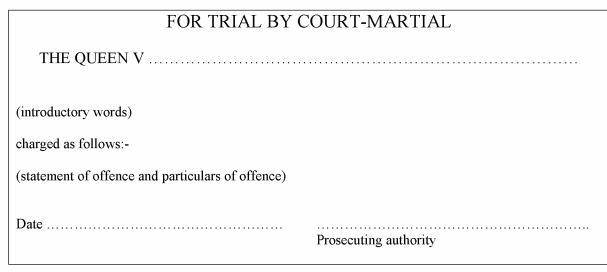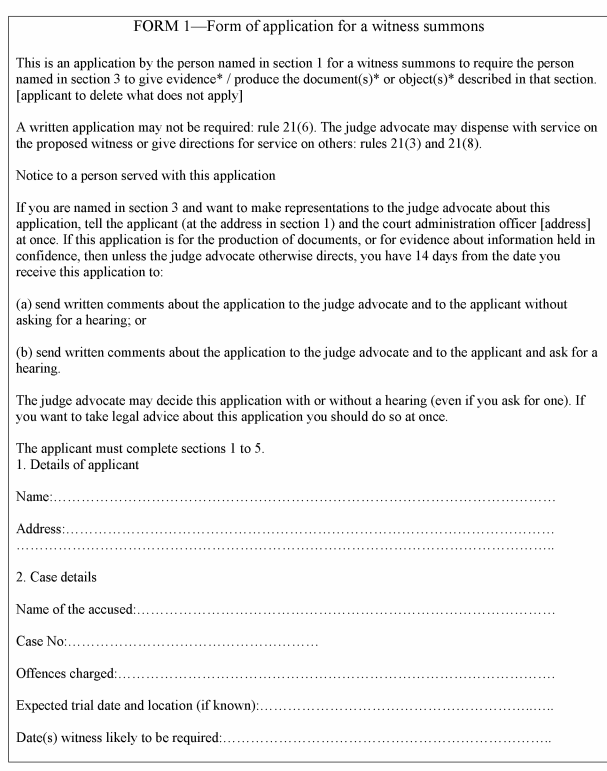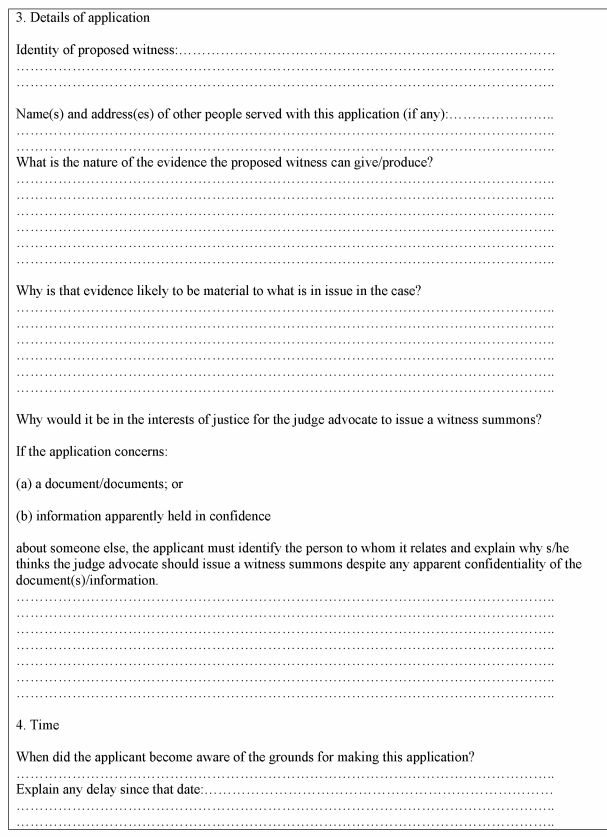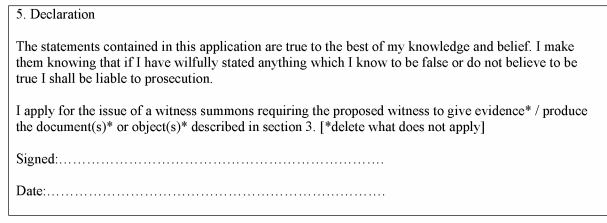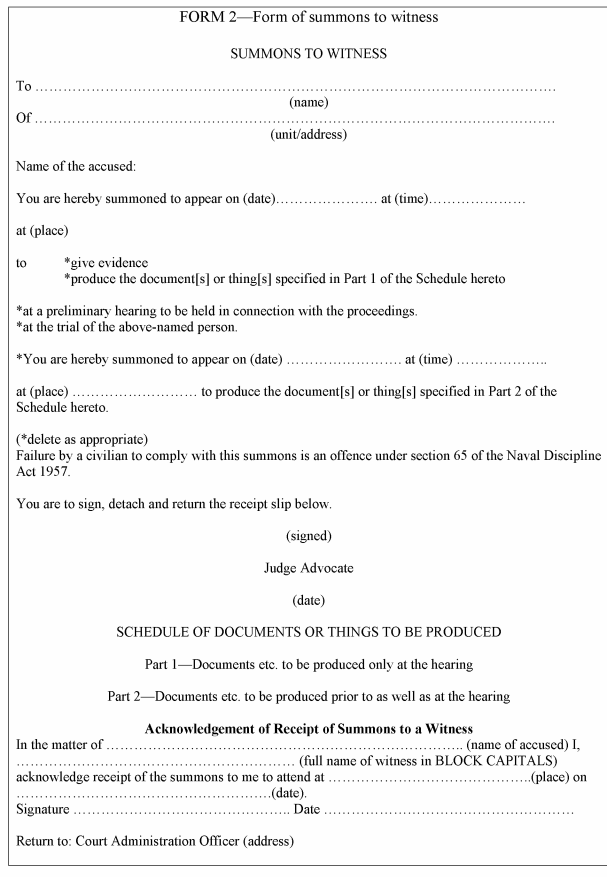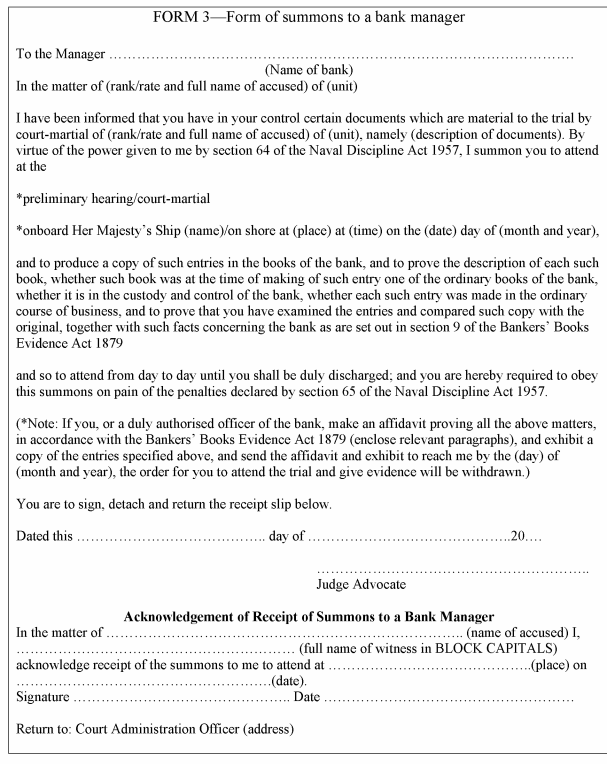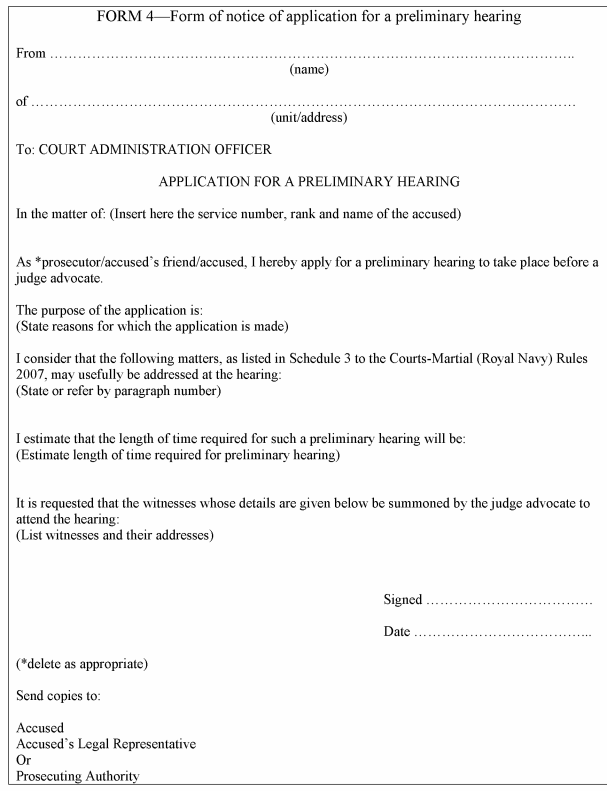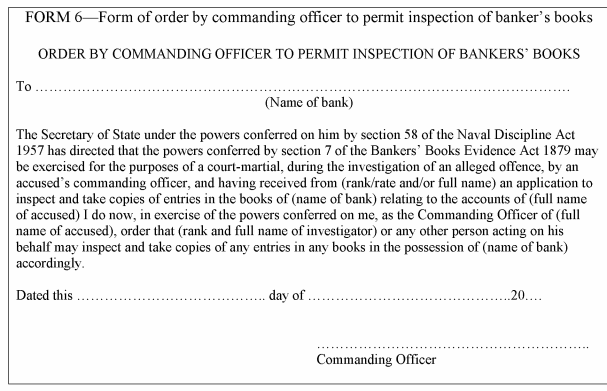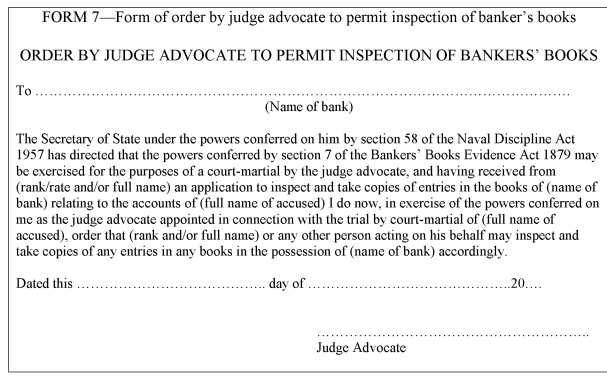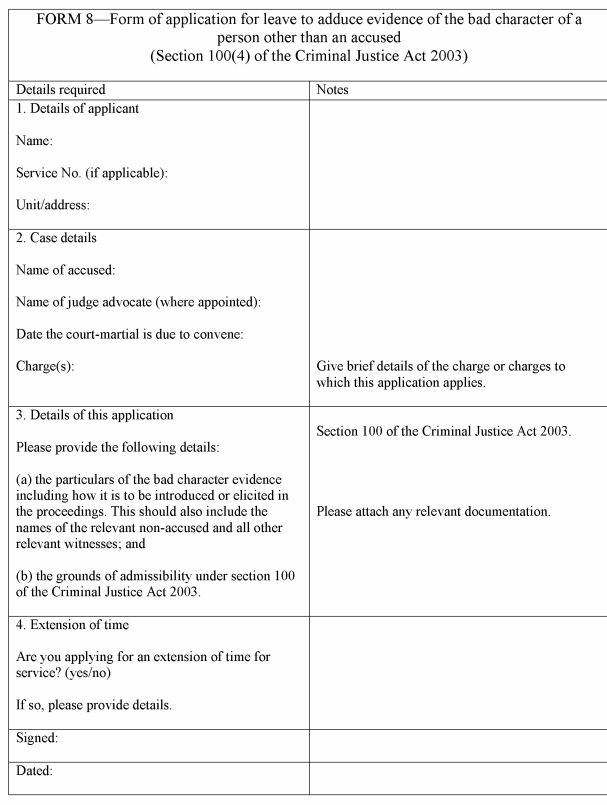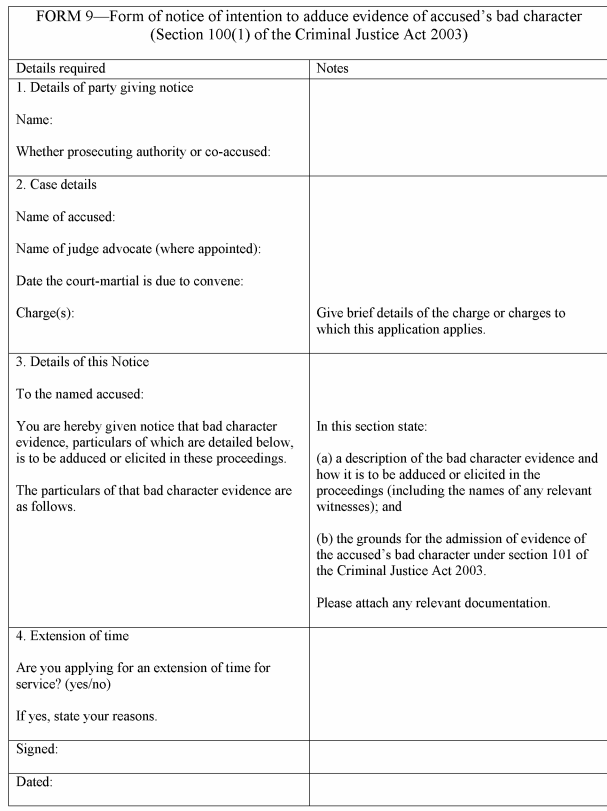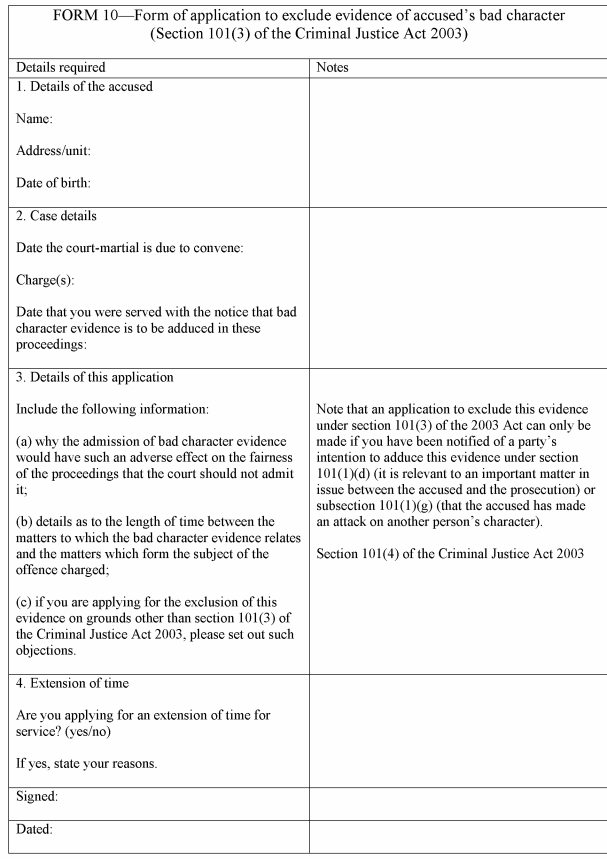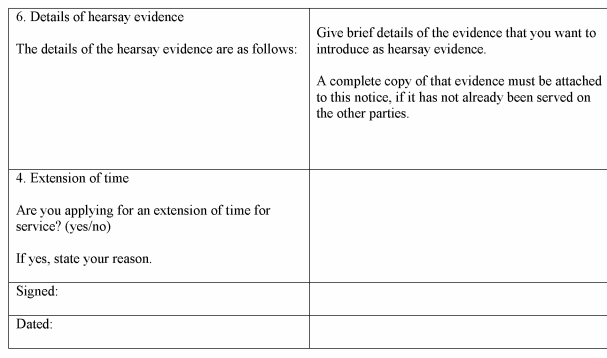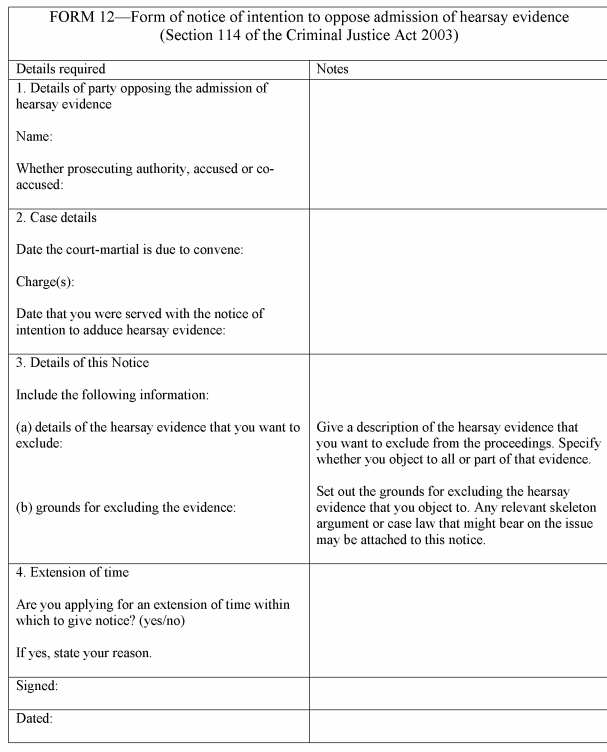- Latest available (Revised)
- Original (As made)
The Courts-Martial (Royal Navy) Rules 2007
You are here:
- UK Statutory Instruments
- 2007 No. 3443
- Schedules only
Status:
This is the original version (as it was originally made). This item of legislation is currently only available in its original format.
Rules 7 and 8
SCHEDULE 1CHARGES AND JOINDER
PART 1RULES
1.—(1) A charge sheet shall be in the form specified in Part 2 of this Schedule or in a form substantially to the like effect, and must contain in a paragraph called a “charge” —
(a)a statement of the offence charged that—
(i)describes the offence in ordinary language;
(ii)identifies any legislation that creates it; and
(b)such particulars of the conduct constituting the commission of the offence as to make clear what the prosecuting authority alleges against the accused.
2. More than one incident of the commission of the offence may be included in a charge if those incidents taken together amount to a course of conduct having regard to the time, place or purpose of commission.
3.—(1) An charge sheet may contain more than one charge if all the offences charged—
(a)are found on the same facts; or
(b)form or are a part of a series of offences of the same or similar character.
4. The charges must be numbered consecutively
5. Where an offence created by or under an enactment states the offence to be the doing or the omission to do any one of any different acts in the alternative, or the doing or the omission to do any act in any one of any different capacities, or with any one of any different intentions, or states any part of the offence in the alternative, the acts, omissions, capacities or intentions, or other matters stated in the alternative in the enactment or subordinate instrument may be stated in the alternative in a charge sheet charging the offence.
6. It shall be sufficient in a charge sheet to describe a person whose name is not known as a person unknown.
7. Where the offence charged is one which can be committed in circumstances involving either a higher or a lower degree of punishment, the charge shall state the facts which it is intended to prove as rendering the accused liable to the higher degree of punishment if convicted.
8. Where the offence charged is one which may render the accused liable to the punishment of stoppages, the charge shall state any additional facts which it is intended to prove as rendering the accused liable to that punishment if convicted.
PART 2FORM
Rules 21, 30, 31, 33, 64 and 89
SCHEDULE 2FORMS
Where any rule requires the use of a form set out in this Schedule, that requirement shall be satisfied by the use of a form substantially to the like effect as the form set out below.
Form 1—Form of application for a witness summons
Form 2—Form of summons to witness
Form 3—Form of summons to a bank manager
Form 4— Form of application for a preliminary hearing
Form 5—Form of notice of application for leave to adduce evidence through television link
Form 6—Form of order by commanding officer to permit inspection of bankers’ books
Form 7—Form of order by judge advocate to permit inspection of bankers’ books
Form 8—Form of application for leave to adduce evidence of the bad character of a person other than an accused
Form 9—Form of notice of intention to adduce evidence of accused’s bad character
Form 10—Form of application to exclude evidence of accused’s bad character
Form 11—Form of notice of intention to adduce hearsay evidence
Form 12—Form of notice of intention to oppose admission of hearsay evidence
Rules 33 and 37
SCHEDULE 3PRELIMINARY HEARING
The matters which may be addressed at a preliminary hearing shall include—
1. the issues in the case;
2. any matters concerning the proper and efficient management of the case including giving parameters to the court administration officer for the listing of the case for trial;
3. issues, if any, as to the mental or medical condition of any accused or witness;
4. the number of witnesses whose evidence will be placed before the court either orally or in writing;
5. the defence witnesses in paragraph 4 whose statements have been served and whose evidence the prosecution will agree and accept in writing;
6. any prosecution witnesses whom the defence require to attend at the trial;
7. any additional witnesses who may be called by the prosecution and the evidence that they are expected to give;
8. any issues as to disclosure;
9. any alibi which should already have been disclosed in accordance with section 11 of the Criminal Justice Act 1967;
10. facts which are to be admitted and which can be reduced into writing in accordance with section 10(2)(b) Criminal Justice Act 1967(1), within such time as may be directed at the hearing, and of any witness whose attendance will not be required at the trial;
11. any exhibits and schedules which are to be admitted;
12. the order and pagination of the papers to be used by the prosecution at the trial and the order in which the prosecution witnesses are likely to be called;
13. any point of law which it is anticipated will arise in the course of the proceedings;
14. any question as to the admissibility of evidence which appears on the face of the papers, and any authority on which the party intends to rely;
15. any application to be made for evidence to be given through live television;
16. any application for a special measures direction under section 19 of the Youth Justice and Criminal Evidence Act 1999(2);
17. any application for screens, for use by witnesses seeking a visual break between themselves and any relevant parties;
18. whether any video, tape recorder or other technical equipment will be required during the proceedings;
19. where a tape recorded interview has taken place, any dispute or agreement as to the accuracy of any transcript or summary;
20. any other significant matter which might affect the proper and convenient trial of the case, and whether any additional work needs to be done by the parties;
21. the estimated length of any trial, to be agreed more precisely taking account of any views expressed by the judge advocate and the other parties;
22. witness availability and the approximate length of witness evidence;
23. availability of advocate;
24. orders prohibiting or restricting the publication of any matter or excluding the public from any proceedings
25. challenges to the jurisdiction of the court;
26. objection to a charge on the grounds that it is not correct in law;
27. plea that the court is debarred from trying a charge;
28. whether there is a need for any further directions.
Rule 56
SCHEDULE 4OATHS AND AFFIRMATIONS
PART 1MANNER OF ADMINISTERING OATHS AND AFFIRMATIONS
1. The person taking the oath shall hold the New Testament, or if a Jew the Old Testament, in his uplifted hand and shall say, or repeat after the person administering it, the oath provided in Part 2 of this Schedule for that category of person.
2. If any person to whom an oath is administered desires to swear in the form and manner in which an oath is usually administered in Scotland, he may do so with uplifted hand and saying or repeating after the person administering it, the Scottish oath provided in Part 3 of this Schedule for that category of person.
3. If none of the forms of oath provided in this Schedule is appropriate to the religious beliefs of the person taking the oath, an oath may be administered in such form and manner as the person taking the oath declares to be binding on his conscience in accordance with his religious beliefs.
4. A person making a solemn affirmation instead of taking an oath shall say or repeat after the person administering it the affirmation provided in this Schedule for that category of person.
PART 2FORMS OF OATH
President of the board and members other than the judge advocate
5. I swear by Almighty God that I will well and truly try the accused before the court according to the evidence, and that I will duly administer justice according to law and without partiality, favour or affection; and I do further swear that I will not on any account, at any time whatsoever, disclose the vote or opinion of any member of this court-martial, unless thereunto required in due course of law.
Persons under instruction
6. I swear by Almighty God that I will not on any account, at any time whatsoever, disclose the vote or opinion of any member of the court-martial given in these proceedings unless thereunto required in due course of law.
Interpreter
7. I swear by Almighty God that I will well and faithfully interpret and make true explanation of all such matters and things as shall be required of me according to the best of my skill and understanding.
Witness aged 18 years or over
8. I swear by Almighty God that the evidence which I shall give shall be the truth, the whole truth, and nothing but the truth.
Witness under the age of 18 years
9. I promise before Almighty God that the evidence which I shall give shall be the truth, the whole truth, and nothing but the truth.
PART 3FORM OF SCOTTISH OATHS
10. The form of Scottish oath shall in each case be the same as the form of oath set out above except for the relevant category of person, that for the words “I swear by Almighty God” there shall be substituted the words “I swear by Almighty God and as I shall answer to God at the Great Day of Judgement”.
PART 4FORM OF SOLEMN AFFIRMATIONS
11. The form of affirmation shall in each case be the same as the form of oath set out above except for the relevant category of person, that for the words “I swear by Almighty God” there shall be substituted the words “I solemnly, sincerely and truly declare and affirm”.
Rule 88
SCHEDULE 5CIVILIANS
PART 1MODIFICATIONS FOR CIVILIANS
| Rule | Modification |
|---|---|
| 2 | ““period of parental recognisance” means the period specified in an order made against a parent or guardian of the accused under paragraph 14(1) of Schedule 5A to the Army Act or of Schedule 5A to the Air Force Act 1955 or of Schedule 4A to the Act; “service parent or guardian” shall be construed in accordance with paragraph 2(2) of Schedule 4A to the Act;”. |
| 7(1) | In sub-paragraph (a), the omission of the words “service number and rank or rate”. The omission of sub-paragraph (b). |
| 79(1) | In sub-paragraph (a), the omission of the words “and rank or rate”. The omission of sub-paragraphs (b) and (g). For sub-paragraph (c) the substitution of— “(c)any decorations to which he is entitled;” |
For sub-paragraph (h) the substitution of— “(h)details of the employment of the accused.”. |
PART 2ADDITIONAL RULES FOR CIVILIANS
Accused’s parent or guardian
1.—(1) This rule applies where—
(a)an accused is under the age of 18 years, or
(b)the offence with which the accused is charged is alleged to have been committed during a period of parental recognisance.
(2) Where the prosecuting authority or the court administration officer is required to serve any document on the accused under these Rules, he shall as soon as is practicable serve a copy of that document on a parent or guardian of the accused who is a service parent or guardian.
(3) Where the accused has not appointed a legal representative, any parent or guardian of the accused may exercise on behalf of the accused the rights granted to the accused in these Rules may represent the accused in any proceedings of the court-martial in such matter and to such extent as the judge advocate thinks fit.
(4) The judge advocate shall issue a witness summons in accordance with rule 21 in respect of any parent or guardian on whom a document has been served in accordance with sub-paragraph (2) to attend the court-martial.
(5) Any parent or guardian of the accused may, if present—
(a)give evidence on oath and call witnesses; and
(b)address the court.
Rule 91
SCHEDULE 6REVOCATIONS
| Rules revoked | Reference |
| The Courts-Martial (Royal Navy) Rules 1997 | S.I. 1997/170 |
| The Courts-Martial (Royal Navy) (Amendment) Rules 2000 | S.I. 2000/2373 |
The Courts-Martial (Royal Navy) (Amendment) Rules 2002 Naval Discipline Act 1957 (Remedial) Order 2004 | |
| The Courts-Martial (Amendment) Rules 2005 | S.I. 2005/1535 |
| The Courts-Martial (Royal Navy) (Amendment) Rules 2005 | S.I. 2005/3484 |
Sections 9 and 10 of the Criminal Justice Act 1967 are applied to proceedings before courts-martial subject to the modifications prescribed by the Criminal Justice Act 1967 (Application to Courts-Martial) (Evidence) Regulations 1997 (S.I. 1997/173).
1999 c. 23; section 19 of the Youth Justice and Criminal Evidence Act 1999 is applied, with modifications, to proceedings before courts-martial by the Youth Justice and Criminal Evidence Act 1999 (Application to Courts-Martial) Order 2006 (S.I. 2006/2886).
Options/Help
Print Options
PrintThe Whole Instrument
PrintThe Schedules only
Legislation is available in different versions:
Latest Available (revised):The latest available updated version of the legislation incorporating changes made by subsequent legislation and applied by our editorial team. Changes we have not yet applied to the text, can be found in the ‘Changes to Legislation’ area.
Original (As Enacted or Made): The original version of the legislation as it stood when it was enacted or made. No changes have been applied to the text.
Explanatory Memorandum
Explanatory Memorandum sets out a brief statement of the purpose of a Statutory Instrument and provides information about its policy objective and policy implications. They aim to make the Statutory Instrument accessible to readers who are not legally qualified and accompany any Statutory Instrument or Draft Statutory Instrument laid before Parliament from June 2004 onwards.
More Resources
Access essential accompanying documents and information for this legislation item from this tab. Dependent on the legislation item being viewed this may include:
- the original print PDF of the as enacted version that was used for the print copy
- lists of changes made by and/or affecting this legislation item
- confers power and blanket amendment details
- all formats of all associated documents
- correction slips
- links to related legislation and further information resources
More Resources
Use this menu to access essential accompanying documents and information for this legislation item. Dependent on the legislation item being viewed this may include:
- the original print PDF of the as made version that was used for the print copy
- correction slips
Click 'View More' or select 'More Resources' tab for additional information including:
- lists of changes made by and/or affecting this legislation item
- confers power and blanket amendment details
- all formats of all associated documents
- links to related legislation and further information resources
